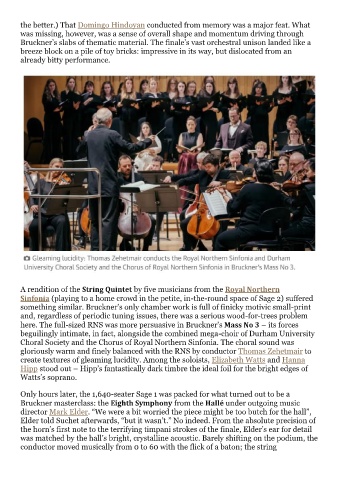Page 220 - Royal Liverpool Philharmonic Coverage Book 2023-24
P. 220
the better.) That Domingo Hindoyan conducted from memory was a major feat. What
was missing, however, was a sense of overall shape and momentum driving through
Bruckner’s slabs of thematic material. The finale’s vast orchestral unison landed like a
breeze block on a pile of toy bricks: impressive in its way, but dislocated from an
already bitty performance.
A rendition of the String Quintet by five musicians from the Royal Northern
Sinfonia (playing to a home crowd in the petite, in-the-round space of Sage 2) suffered
something similar. Bruckner’s only chamber work is full of finicky motivic small-print
and, regardless of periodic tuning issues, there was a serious wood-for-trees problem
here. The full-sized RNS was more persuasive in Bruckner’s Mass No 3 – its forces
beguilingly intimate, in fact, alongside the combined mega-choir of Durham University
Choral Society and the Chorus of Royal Northern Sinfonia. The choral sound was
gloriously warm and finely balanced with the RNS by conductor Thomas Zehetmair to
create textures of gleaming lucidity. Among the soloists, Elizabeth Watts and Hanna
Hipp stood out – Hipp’s fantastically dark timbre the ideal foil for the bright edges of
Watts’s soprano.
Only hours later, the 1,640-seater Sage 1 was packed for what turned out to be a
Bruckner masterclass: the Eighth Symphony from the Hallé under outgoing music
director Mark Elder. “We were a bit worried the piece might be too butch for the hall”,
Elder told Suchet afterwards, “but it wasn’t.” No indeed. From the absolute precision of
the horn’s first note to the terrifying timpani strokes of the finale, Elder’s ear for detail
was matched by the hall’s bright, crystalline acoustic. Barely shifting on the podium, the
conductor moved musically from 0 to 60 with the flick of a baton; the string

